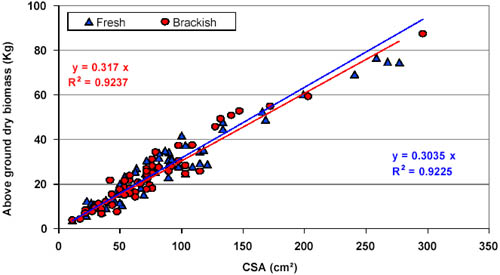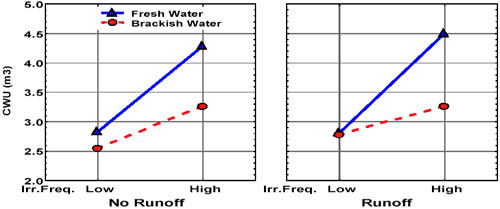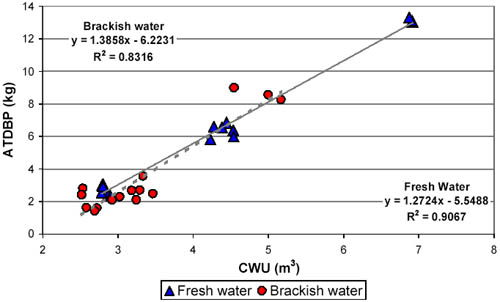

0304-B1
E. Garcia[1] and P. Berliner
The effects of irrigation frequency and water quality on the biomass production of Acacia saligna mature shrubs (planted to a density of 2 500 shrubs ha-1) were evaluated in a field trial carried out in Sede Boker, Israel (31(08’ North and 34(53’ South). Three irrigation frequencies: eight (well-watered - WW), four (high frequency - H) and two (low frequency - L) applications per month were applied using fresh (F) (1 dS m-1) and brackish (B) (6 dS m-1) water. Soil water content in the soil profile to a depth of 2.4 m. was monitored before and after irrigation using a neutron moisture meter. One access tube was located midway between two trees in the row and two additional ones at 1 and 2 m from the row.
Annual Total Dry Biomass Production (ATDBP) at the end of the trial period was obtained by lopping the shrubs at a height of 1.50 m. Diameters of trunks were measured 20 cm above ground every fifteen days and the Cross Sectional Area (CSA) computed. A linear correlation between CSA and ATDBP was derived and used to estimate the biomass evolution during the 1999 growing period.
The highest CSA was found in the WW treatments and in the high irrigation frequencies. The yields of WWB plots were roughly four times higher than LB plots. Consumptive Water Use (CWU) in plots irrigated with brackish water was lower than in plots irrigated with fresh water. Irrigation frequency increased Gross Water Use Efficiency (GWUE) for F treatments.
The biomass production increased linearly with CWU, and was not affected by water quality.
It has already been sustained that in arid and semiarid lands there is demand of firewood (Lovenstein et al., 1993; Droppelmann, 2000). Beside this requirement there are scarcity on this source of energy as well as irrigation water supply.
In drylands there are a significant climatic variability, in particular in terms of precipitation (Bruins and Berliner, 1998). The natural shortage of these areas is linked with increment of water use, resulting in its excessive utilization and consequently in the need of the use of marginal water. The current water scarcity in the Negev Desert, it move us to explore the possibility of include saline water in the irrigation regimes (Oron et al, 1999).
Fuelwood plantations with fast growing trees may mitigate the problem of scarcity of this source of energy. Providing these trees with a reasonable amount of water during dry periods may insure tree survival and have a moderate biomass production for firewood and even for forage. The application of brackish water to relatively resistance trees may be feasible, particularly in the case of runoff irrigated trees, in which case the salts may be leached with application of flooding in the plot.
The objetives of this research were:
1. To evaluate the effect of the brackish water irrigation on the whole tree biomass produccion
2. To evaluate the irrigation frequencies on the tree biomass production
The experimental plot was located in the Sede Boker Campus (31° 08' N, 34°53' E, 400 m.a.s.l.) of the Jacob Blaustein Institute for Desert Research, Ben Gurion University of the Negev, in Israel, with an annual precipitation in 1999 of 40 mm. The region is on the border between arid and hyper-arid (between 0.04-0.05 P/PET ratio) according UNEP classification (1997). In the experiment site, Acacia saligna (Labill.) H. Wendl shrubs were planted at a density of 2500 trees Ha-1; it had thirty-three plots of 75 m² each in a factorial arrange with 11 treatments in three randomized blocks.
For the irrigation, salt water was prepared with an electric conductivity of 6 dS m-1, for some treatments and for the others, fresh water was used. These waters were applied to the plot with a drip irrigation system. The plots of the treatments with runoff received water equivalent to a 250 mm. To follow the development of soil water content and the water status in the plant, predawn and mid-day Phyllode Water Potential (LWP) were measured using the Pressure Chamber Method (Scholander et al, 1965).
For the production of biomass, we measure the increment of the CSA every 15 days. Phyllode fall was also collected. At the end of the measurement season, a total of 528 shrubs were lopped. Shrubs were sawed at a height of 1.50 m above ground and separated into phyllodes, twigs and branches, determining immediately the fresh weight. Representative samples of each group were obtained and oven dried at 65°C, until a constant weight was reached. The standing biomass production was estimated annually and the seasonal biomass production was estimated from allometric relationships for each component according to the procedure of Droppelmann et al. (2000).
Statistix for Windows v. 2.0 was used to conduct the statistical analysis and the plant growth analysis was carried out following Droppelmann et al., (2000) and Hunt (1978).
In Fig. 1, the last CSA is presented as a function of dry biomass irrigated with fresh and brackish water. The correlation for both cases were computed separately. No significant difference was found between their slopes.
Fig. 1. Relationship between above ground dry biomass of the whole shrub and Cross Sectional Area (CSA) for both water qualities.

Fig. 2. Relative Growth Rate of Acacia saligna during 1999 for high irrigation frequency treatments. (For the legends refer to the text).

Although the little increase of the CSA, towards the end of the summer RGR values of WWB (well watered using brackish water), HF (Irrigated with fresh water at high frequency), HFR (combination of runoff and irrigation thereafter with fresh water at high frequency), HB (Irrigated with brackish water at high frequency), and LF (irrigated with fresh water at low frequency) decreased. But R, LBR (combination of runoff and irrigation thereafter with brackish water at low frequency), HBR (combination of runoff and irrigation thereafter with brackish water at high frequency), showed a small increment (Fig. 2).
For the ATDBP, the highest whole shrub biomass production was for WWF (well watered using fresh water) (13.14 Kg/shrub), two times more than HFR (6.40 Kg/shrub) and HF (6.32 Kg/shrub) which showed the best productions among treatments 2 to 9. The lowest production was for R (1.54 Kg/shrub). The Analysis of Variance (ANOVA) (treatments 2 - 9) showed the same characteristics than the yield components.
In Fig. 3 the significant interaction between water quality and irrigation frequency is presented. Increasing the frequency of irrigation, we increase the ATDBP, much more with fresh water than with brackish water. Nevertheless, one can see that the increment even though small it is positive.
Fig. 3. Factor Interactions (Irrigation Frequency, Water Quality) for ATDBP of Acacia saligna shrub during 1999.

As the water content in the soil decreases, the water potential in the phyllode decreased. This behavior was observed for fresh water as well as for brackish water irrigation. The brackish treatments appear to have a lower predawn PWP for the same water content. These WW plots did not change strongly when the water content in the soil changed, which was between 188 to 250 mm for WWF which correspond to 16 to 5 bars during all the season.
Fig. 4. Plot of means 3-way interaction (Water quality, Irrigation frequency, and Runoff) for water consumption (CWU) of Acacia saligna during 1999.

Fig. 5. Plot of means 2-way interaction for Gross Water Use Efficiency (GWUE) of Acacia saligna during 1999.

The highest GWUE was for WW treatments. The lowest was for low frequency treatments with no noticeable difference between brackish and fresh water. For the brackish treatment, no significant difference between low and high frequencies could be found and runoff application had no significant effect. When runoff was applied there was an increase in GWUE for the brackish treatments as well, albeit a small one (Fig. 5).
Fig. 6. Relationship between Consumptive Water Use (CWU) and Annual Total Dry Biomass Production (ATDBP) grouped by water quality for Acacia saligna during 1999.

Our results show that there is a highly significant influence of the irrigation frequency on the standing ATDBP. The lowest production of phyllodes was found for R. For branch, twig, and trunk production, all the treatments in the low irrigation frequency were lower than the high irrigation frequency. The effect of brackish water application is not evident, which correspond to the results of Sweeney et al., (1997) for Eucalyptus camaldulensis trees irrigated with saline drainage water (Electric Conductivity [EC] between 3 to 10.6 dS m-1).
Quite a strong correlation was found between CSA and shrub components, and between CSA and whole shrub (Fig. 1). These relationships are linear and similar to those found by other authors for the same variables (Droppelmann, et al., 2000; Lott et al., 2000; Lovenstein et al.; 1993; Nygren et al., 1993).
For the relative growth rate (RGR), according to Larocque et al., (1992), is related to the development of the shrub and the availability of the resources. In our experiment, the RGR was a result of the effect of the treatments and the extreme environmental conditions (high temperature, high radiation, and low relative humidity coupled to high wind speed). This led to different rhythms of shrub development. High irrigation frequencies showed high RGR, throughout the season, which means high growth rate.
In spite that HF had a lower biomass production than WWF, the peaks of RGR for HF in some periods of development were higher than WWF. HFR had constant RGR during the year and the highest annual biomass production among treatments 2 to 9 (Fig. 2). This leads us to conclude that less fluctuations of RGR leads to higher biomass productions.
Differences due to water quality and irrigation frequency were found for all components and for the whole shrub. The high frequency and fresh water applications produced the highest yields for all components (treatments 2-9) (Fig. 3).
The production of the treatments with brackish water in HB (2.78 kg shrub-1), LB (2.28 Kg shrub -1) and WWB (8.60 Kg shrub-1) was higher than that found by Singh et al. (1996) for Dalbergia sisso with the same level of salinity. The South Asian multipurpose tree grew in water with EC of 6 dS m-1 and produced 0.325 Kg plant-1 of dry biomass with approximately 918 mm of rainfall.
The highest water application was for the highest irrigation frequency, showing at the same time that the higher CWU was for the fresh water treatments (WWF and HFR) (Fig. 4). High interaction between frequency and water quality also was observed. Suggesting that after some salinity limits we can keep an amount of CWU. Sweeney et al. (1997) reported similar findings in a trial in which he compared five different water salinities and applications of N and P. He found that Eucalyptus tree irrigated with 7.5 dS m-1 had 706 mm year-1 of water use. This consumption was lower than the WU of our shrubs (825 mm/season for HB and LB).
The ATDBP increased linearly with CWU, and was not affected by water quality (Fig. 6). The WUE of this correlation was 1.3 Kg m-3, which is lower than the values found by Nativ et al., (1998) (average of 2.57 g DM LH2O-1) for shrubs grown in pots. The difference between our WUE and Nativ’s value is probably due to the fact that in the trial of the latter evaporation from the soil surface was negligible. From the point of view of water use, it is clear that the use of brackish water did not affect the correlation. This means that the mechanism responsible for the decrease in biomass production due to brackish water application is through the decrease in transpiration.
The present research studied the effect of different irrigations regimes, two levels of water quality and runoff on the biomass production of Acacia saligna and led us to the following conclusions:
- For the standing biomass production after five years of growth there is a significant effect of the irrigation frequency and runoff. No effect of the water quality was detected.
- For the annual biomass production during the fifth year there was a significant effect of irrigation frequencies, water quality, and their interactions. An increase in the frequency of irrigation increased the biomass of fresh and brackish treatments, even though less for the latter than the former. The runoff irrigation did not have effect biomass production.
- There was a strong correlation between CSA and shrub components, and CSA and whole shrub.
- The plots with fresh water and in high irrigation frequency (HF, WWF) had less fluctuations of RGR and more constant rhythm of growth.
- For high irrigation frequency the water uptake was mainly from the upper layers (30-75 cm depth) and for low irrigation frequency from almost all the layers (90-120 cm depth). The higher water consumption was for fresh water treatments.
- The biomass production (ATDBP) increased linearly with consumptive water use (CWU), and was not affected by water quality.
- The ratio of evaporation to CWU was negatively and linearly related to the number of irrigations and this behavior was due to the differences in canopy size.
This research was part of the thesis submitted to the Ben Gurion University in partial fulfillment of the requirement of the degree of Master of Science in desert studies. It was hold by the programme “Agriculture and Biotechnology for Sustainable Dryland Development” supported by the Capacity 21 Trust Fund in United Nations Development Program (UNDP) through the national Capacity 21 programme in Bolivia, 1999-2000. Grateful acknowledgment is made to all members of the Wyler Department for Dryland Agriculture from the Jacob Blaustein Institute in the Negev Desert, Israel.
Berliner, P.R.; C. Wexler and J. E. Ephrath (1998) Biomass Production of Acacia Saligna as Affected by Several Watering Regimes and Water Quality. In American Society of Agronomy A.S.A. Annual Meeting 1998.
Bruins, H., P.R. Berliner (1998) Bioclimatic Aridity, Climatic Variability, Drought and Desertification: Definitions and Management Options. In: The Arid Frontier, 97-116. Kluwer Academic Publishers. Netherlands.
Droppelmann, K.J., P.R. Berliner (2000) Biometric relationships and Growth of Pruned and Non-Pruned Acacia saligna under Runoff Irrigation in Northern Kenya. Forest Ecology and Management 126 (2000) 349-359. Elsevier Science Publishers. Netherland.
Hunt, R. (1978) Plant Growth Analysis. Edward Arnold Publishers. London. 66 pag.
Lott, J.E., S.B. Howard, C.R. Black (2000) Allometric Estimation of Above-Ground Biomass and Leaf Area in Managed Grevillea robusta Agroforestry Systems. Agroforestry Systems 49:1-15, 2000. Kluwer Academic Publishers. Netherlands.
Lovenstein, H.M., P.R. Berliner (1993) Biometric Relationships for Non-Destructive Above Ground Biomass Estimations in Young Plantations of Acacia salicina Lindl. and Eucalyptus occidentalis Endl. New Forest 11:255-273, 1993. Kluwer Academic Publishers. Netherlands.
Nativ R., J. E. Ephrath, P. R. Berliner and Y. Saranga (1998) Drought Resistance and Water Use Efficiency in Acacia saligna. Aust. J. Bot. (47) 577-586.
Nygren, P., S. Rebottaro, R. Chavarria (1993) Application of the Pipe Model Theory to Non-Destructive Estimation of Leaf Biomass and Leaf Area of Pruned Agroforestry Trees. Agroforestry Systems 23: 63-77, 1993. Kluwer Academic Publishers. Netherland.
Oron, G., Y. DeMalach, L. Gillerman, I. David, V.P. Rao (1999) Improved Saline-Water Use Under Subsurface Drip Irrigation. Agricultural Water Management 39 (1999) 19-33. Elsevier Science Publishers. Netherlands.
Sauerhaft, B.C. (1997) Runoff Harvesting and Agroforestry: Sustainable Solutions Aiding Arid Resource Management. Thesis submitted to the office of Graduate Studies of Texas A&M University. 130 p.
Scholander, P. K., H. T. Hammel, E. D. Bradstreet and E. A. Hemmingsen (1965) Sap Pressure in Vascular Plants. Science 148, 339-346.
Singh, Y.P., P.S. Minhas, O.S. Tomar, R.K. Gupta, Raj K. Gupta (1996) Salt Tolerance and Water Use by Dalbergia sisso During the Establishment Stage. Arid Soil Research and Rehabilitation, 10:379-390, 1996.
Sweeney, S.M., R.M. Stevens (1997) Growth and Water Use of Eucalypt trees Irrigated With Saline Drainage Water. Irrigation Science (1997) 17:173-181.
United Nations Environment Programme (UNEP) (1997) World Atlas of Desertification. Arnold Publishers. London. 182 pag.
| [1] Ecology Department, Alicante
University, Sant Vicent del Raspeig, Ap. 99 E-03080 Alicante, Spain. Tel:
0034-965-90-3625; Fax 0034-965-90-3625; Email: [email protected]
|